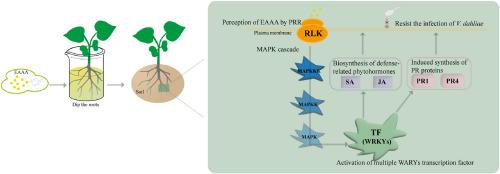Ethyl acetate extract of Artemisia argyi improves the resistance of cotton to Verticillium dahliae by activating the immune response
IF 6.1
2区 生物学
Q1 PLANT SCIENCES
引用次数: 0
Abstract
Verticillium wilt, a significant pathogen affecting cotton, has historically been challenging to control, posing a substantial threat to the sustainable development of the cotton industry. This study demonstrates that resistance to Verticillium dahliae in cotton can be enhanced by treating the roots with an ethyl acetate extract (EAAA) extracted from Artemisia argyi. The mechanisms by which EAAA activates immunity in cotton were elucidated by examining the expression levels of resistance genes post-treatment, evaluating salicylic acid (SA) and jasmonic acid (JA) levels, analyzing transcriptome data, and employing virus-induced gene silencing (VIGS) technology. Additionally, pot experiments were conducted to validate the efficacy of EAAA in controlling Verticillium wilt. The flavonoid content in EAAA was qualitatively analyzed using Ultra-Performance Liquid Chromatography coupled with Tandem Mass Spectrometry (UPLC-MS/MS), identifying three specific flavonoids that were further screened to verify their roles in activating cotton immunity. Cotton plants treated with EAAA exhibited reduced leaf chlorosis and browning in the vascular bundles. Genes involved in SA and JA synthesis and signaling in the root system were highly expressed, resulting in increased levels of SA and JA. Transcriptome analysis revealed that most upregulated differentially expressed genes were primarily enriched in the Mitogen-Activated Protein Kinase (MAPK) signaling pathway. Two specific genes, RLK and MAPKKK18, were identified through VIGS technology as key regulators of the immune pathway in cotton. The flavonoid monomer activation experiment demonstrated that eupatilin, hispidulin, jaceosidin, and a mixture of these three could induce the expression of cotton-related resistance genes. Collectively, these findings provide a research basis for the development of EAAA as a natural plant immune-inducing agent against cotton Verticillium wilt.

青蒿乙酸乙酯提取物通过激活免疫反应提高棉花对大丽轮枝菌的抗性
枯萎病是影响棉花的重要病原体,历来难以控制,对棉花产业的可持续发展构成了巨大威胁。本研究证明,用从青蒿中提取的乙酸乙酯提取物(EAAA)处理棉花根部可增强其对大丽轮枝菌的抗性。通过检测处理后抗性基因的表达水平、评估水杨酸(SA)和茉莉酸(JA)水平、分析转录组数据以及采用病毒诱导基因沉默(VIGS)技术,阐明了EAAA激活棉花免疫力的机制。此外,还进行了盆栽实验,以验证 EAAA 在防治轮纹枯萎病方面的功效。利用超高效液相色谱-串联质谱法(UPLC-MS/MS)对EAAA中的黄酮类化合物含量进行了定性分析,确定了三种特定的黄酮类化合物,并进一步筛选验证了它们在激活棉花免疫力方面的作用。经 EAAA 处理的棉花植株叶片萎黄和维管束褐变现象有所减少。根系中参与 SA 和 JA 合成和信号转导的基因高度表达,导致 SA 和 JA 水平升高。转录组分析表明,大多数上调的差异表达基因主要集中在丝裂原活化蛋白激酶(MAPK)信号通路中。通过 VIGS 技术,发现 RLK 和 MAPKKK18 这两个特定基因是棉花免疫途径的关键调控因子。黄酮类化合物单体激活实验表明, eupatilin、hispidulin、jaceosidin 以及这三种化合物的混合物可以诱导棉花相关抗性基因的表达。总之,这些发现为开发 EAAA 作为天然植物免疫诱导剂防治棉花轮纹枯萎病提供了研究基础。
本文章由计算机程序翻译,如有差异,请以英文原文为准。
求助全文
约1分钟内获得全文
求助全文
来源期刊
CiteScore
11.10
自引率
3.10%
发文量
410
审稿时长
33 days
期刊介绍:
Plant Physiology and Biochemistry publishes original theoretical, experimental and technical contributions in the various fields of plant physiology (biochemistry, physiology, structure, genetics, plant-microbe interactions, etc.) at diverse levels of integration (molecular, subcellular, cellular, organ, whole plant, environmental). Opinions expressed in the journal are the sole responsibility of the authors and publication does not imply the editors'' agreement.
Manuscripts describing molecular-genetic and/or gene expression data that are not integrated with biochemical analysis and/or actual measurements of plant physiological processes are not suitable for PPB. Also "Omics" studies (transcriptomics, proteomics, metabolomics, etc.) reporting descriptive analysis without an element of functional validation assays, will not be considered. Similarly, applied agronomic or phytochemical studies that generate no new, fundamental insights in plant physiological and/or biochemical processes are not suitable for publication in PPB.
Plant Physiology and Biochemistry publishes several types of articles: Reviews, Papers and Short Papers. Articles for Reviews are either invited by the editor or proposed by the authors for the editor''s prior agreement. Reviews should not exceed 40 typewritten pages and Short Papers no more than approximately 8 typewritten pages. The fundamental character of Plant Physiology and Biochemistry remains that of a journal for original results.

 求助内容:
求助内容: 应助结果提醒方式:
应助结果提醒方式:


